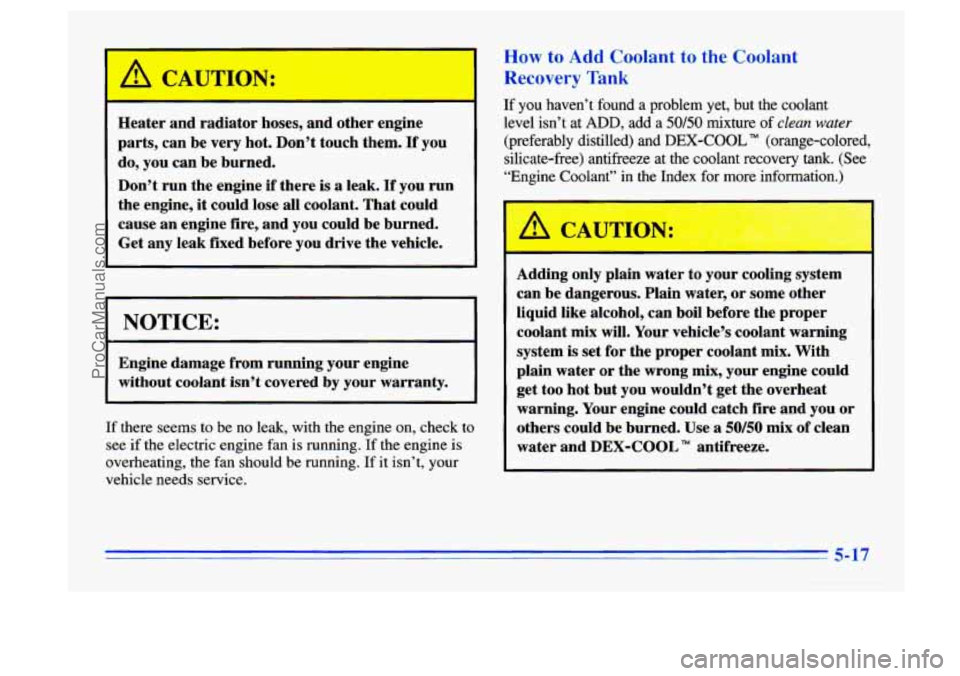Page 183 of 340

A C U-ION:
Heater and radiator hoses, and other engine
parts, can be very hot. Don’t touch them.
If you
do, you can be burned.
Don’t run the engine if there
is a leak. If you run
the engine,
it could lose all coolant. That could
cause an engine fire, and you could be burned.
Get any leak fixed before you drive the vehicle.
NOTICE:
Engine damage from running your engine
without coolant isn’t covered by your warranty.
If there seems to be no leak, with the engine on, check to
see if the electric engine fan is running. If the engine is
overheating, the fan should
be running. If it isn’t, your
vehicle needs service.
How to Add Coolant to the Coolant
Recovery Tank
If you haven’t found a problem yet, but the coolant
level isn’t at ADD, add a
50/50 mixture of clean water
(preferably distilled) and DEX-COOL (orange-colored,
silicate-free) antifreeze at
the coolant recovery tank. (See
“Engine Coolant” in the Index for more information.)
Adding only plain water to your cooling system
can be dangerous. Plain
water, or some other
liquid like alcohol, can boil before the proper
coolant mix will. Your vehicle’s coolant warning
system
is set for the proper coolant mix. With
plain
water or the wrong mix, your engine could
get too hot but you wouldn’t get the overheat
warning. Your engine could catch fire and you or
others could be burned. Use
a 50/50 mix of clean
water and DEX-COOL
TM antifreeze.
5-17
ProCarManuals.com
Page 184 of 340
I I
NOTICE:
In cold weather, water can freeze and crack the
engine, radiator, heater core and other
parts.
Use the recommended coolant and the proper
coolant
mix.
. .. .
i.
You can be burned if you spill coolant on hot
engine parts. Coolant contains ethylene glycol
and
it will burn if the engine parts are hot
enough. Don’t spill coolant on a hot engine.
1
When the coolant in the coolant recovery tank is at the
FULL HOT mark, start your vehicle.
If the overheat warning continues, there’s one more
thing
you can try. You can add the proper coolant mix
directly to the raqiator, but be sure the cooling system is:
cool before you do it.
I
5-18
ProCarManuals.com
Page 186 of 340
How to Add Coolant to the Radiator
I NOTICE:
r
Your engine has a specific radiator fill procedure.
Failure to
follow this procedure could cause your
engine to overheat and be severely damaged.
1. You
can remove the
radiator pressure cap
when the cooling
system, including the
radiator pressure cap and
upper radiator hose, is no longer hot.
2. Then keep turning
the pressure cap,
but
now push down as you
turn it. Remove the
pressure cap.
Turn the pressure cap slowly counterclockwise until
it first stops. (Don’t press down while turning
the
pressure cap.)
If you hear a hiss, wait for that to stop. A hiss means
there
is still some pressure left.
,A CAUTION:
You can be burned if you spill coolant on hot
engine parts. Coolant contains ethylene glycol
and it will burn if the engine parts are hot
enough. Don’t spill coolant on a hot engine.
5-20
ProCarManuals.com
Page 187 of 340
i,I *La "
2.2L L4 Engine
The 2.2L Engine (VIN Code 4) has one bleed valve
located at the thermostat housing.
L L
3.1L V6 Engine
3. After the engine cools, open the coolant air
bleed valve.
3.1 L V6 (VTN Code M): There are two bleed valves.
One
is located on the thermostat housing. The other
is located on the thermostat bypass tube.
5-21
ProCarManuals.com
Page 188 of 340
4. Fill the radiator with the proper mix, up to the base
of
the filler neck.
If you see a stream of coolant coming from an air
bleed valve, close
the valve. Otherwise, close the
valves after the radiator is filled.
5. Rinse or wipe any spilled coolant from the
engine compartment.
6. Then fill the coolant recovery tank to the FULL
HOT mark.
7. Put the cap back on the coolant recovery tank, but
leave the radiator pressure cap
off.
5-22
ProCarManuals.com
Page 189 of 340
8. Start the engine and let it run until you can feel the
upper radiator hose getting hot. Watch out for the
engine fan.
9. By this time the coolant level inside the radiator
filler neck may be lower.
If the level is lower, add
more
of the proper mix through the filler neck until
the level reaches the base of the filler neck. 10.
Then replace the
pressure cap. At any
time during this
procedure
if coolant
begins to
flow out of
the filler neck, reinstall
the pressure cap. Be
sure the arrows on
the
pressure cap line up
like this.
11. Check the coolant
in the recovery tank. The level in
the coolant recovery tank should be at the HOT
mark when the engine is hot or at the COLD mark
when
the engine is cold.
5-23
ProCarManuals.com
Page 214 of 340
When you open the hood of your 2.2L engine you’ll see:
D. Engine Oil Cap and Dipstick G. Engine Fan
E. Automatic Transaxle Dipstick H. Air Cleaner
F. Brake Fluid Reservoir 1. Battery
A. Windshield Washer Reservoir
B. Engine Coolant Reservoir
C. Power Steering Reservoir
6-8
ProCarManuals.com
Page 215 of 340
When you open the hood of your 3.1 L engine you’ll see:
A
A. Windshield Washer Reservoir
B. Engine Coolant Reservoir
C. Power Steering Reservoir
D. Automatic Transaxle Dipstick
E. Oil Fill Cap
E Engine Oil Dipstick
G. Brake Fluid Reservoir
H. Engine Fan
I. Air Cleaner
J. Battery
6-9
ProCarManuals.com